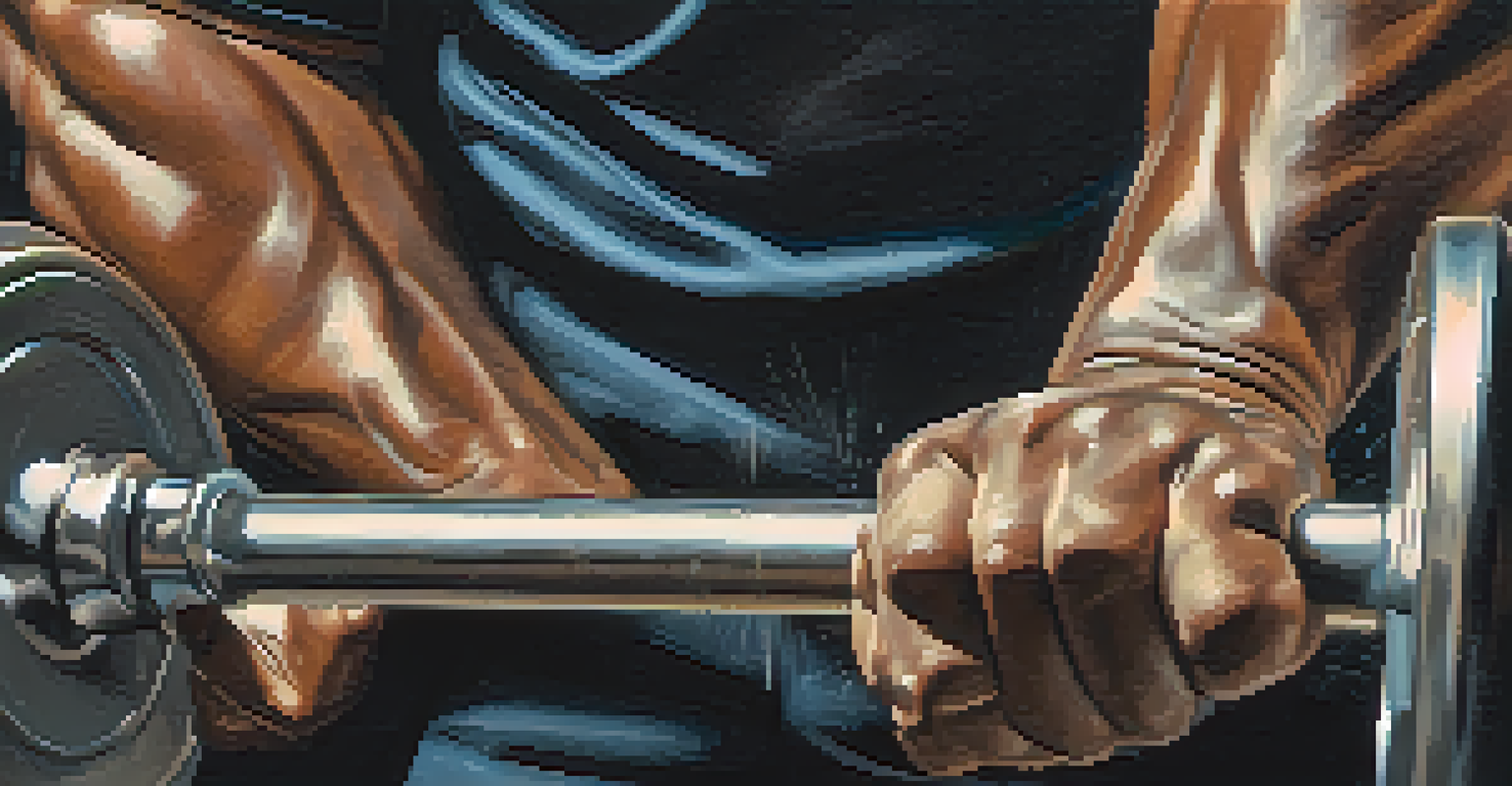Intense Cardio vs. Low-Intensity: Which for Powerlifters?

Understanding Powerlifting and Its Demands
Powerlifting is a strength sport focused on maximizing the amount of weight lifted in three main lifts: the squat, bench press, and deadlift. This discipline demands not only muscle strength but also optimal energy levels and recovery. Powerlifters often need to balance their training routines to avoid fatigue while still improving performance.
Strength does not come from physical capacity. It comes from an indomitable will.
To excel in powerlifting, athletes must develop explosive strength and endurance. This can lead to questions about how to incorporate cardio without compromising strength gains. Understanding the role of cardio can help powerlifters tailor their training to their specific goals.
Cardio can enhance cardiovascular fitness, which is crucial for overall health and can play a role in recovery. However, the type and intensity of cardio chosen can significantly influence a powerlifter's performance. So, what’s the best approach: intense or low-intensity cardio?
The Case for Intense Cardio Workouts
Intense cardio workouts, such as high-intensity interval training (HIIT), can provide significant cardiovascular benefits in a shorter amount of time. This form of training can increase heart rate quickly and improve aerobic capacity, which may help in recovery between heavy lifts. For powerlifters looking to maintain strength while improving endurance, this can be an appealing option.

Moreover, intense cardio can help with fat loss, which is often a goal for athletes looking to achieve a specific weight class. By incorporating short bursts of high-intensity effort, powerlifters can burn calories effectively without spending hours on traditional cardio machines. This can help maintain a competitive edge while preserving muscle mass.
Balance Cardio for Powerlifting
Powerlifters should find the right balance between intense and low-intensity cardio to enhance strength and recovery.
However, the intensity of these workouts can also lead to fatigue, especially if not balanced properly with strength training. Powerlifters need to be mindful of recovery times and listen to their bodies to avoid overtraining. So, while intense cardio can be beneficial, it requires careful planning within a powerlifting regimen.
Benefits of Low-Intensity Cardio for Recovery
Low-intensity cardio, such as walking, cycling, or swimming, offers a gentler approach that can be beneficial for recovery. It allows powerlifters to keep moving without placing additional strain on their muscles or joints. This is particularly important after heavy lifting sessions to promote blood flow and aid in recovery.
The only bad workout is the one that didn’t happen.
Additionally, low-intensity cardio can help maintain a healthy weight without the stress that intense workouts can impose. It’s an excellent way to burn calories while allowing the body to recover from the rigors of powerlifting. This can be crucial for athletes who are focusing on long-term performance rather than quick fixes.
Incorporating low-intensity sessions can create a balanced approach to overall fitness. It allows powerlifters to remain active while giving their muscles the time they need to recover, ultimately enhancing their ability to perform in the gym. So, while it may seem less exciting, low-intensity cardio has its place in a powerlifter's routine.
Finding the Right Balance Between Cardio Intensities
The key to successful training for powerlifters often lies in finding the right balance between intense and low-intensity cardio. Each athlete's needs will vary based on their specific goals, training phases, and personal preferences. A well-rounded approach can help maximize strength while improving cardiovascular fitness.
Many powerlifters may benefit from a combination of both cardio types. For example, they might perform intense cardio once or twice a week while incorporating low-intensity sessions on off days. This strategy can help enhance recovery and maintain fitness without detracting from strength training.
Listen to Your Body's Signals
Paying attention to how you feel during workouts can help adjust cardio intensity and ensure optimal training effectiveness.
Ultimately, the right balance is about listening to your body and adjusting your routine accordingly. It’s important to monitor performance and recovery to find what works best for you. This personalized approach ensures that you’re not only lifting heavy but also supporting your overall health and fitness.
Listening to Your Body: Signs to Consider
One of the most important aspects of any training regimen is understanding your body's signals. Powerlifters should pay attention to how they feel during and after workouts to gauge whether their cardio routine is effective. Signs of fatigue or decreased performance may indicate a need for more recovery time or a change in cardio intensity.
If you find yourself feeling drained after intense cardio sessions, it might be time to dial it back. Conversely, if low-intensity sessions feel too easy and you’re not seeing the results you want, you may need to incorporate more challenging cardio. The goal is to align your cardio with your overall training objectives.
Listening to your body also means adjusting your routine based on upcoming competitions or personal goals. If you’re in a heavy lifting phase, prioritize recovery and consider low-intensity sessions. If you’re preparing for a competition, integrating some intense cardio might be necessary. Adapting your approach keeps your training fresh and effective.
Cardio Timing: When to Include It in Training
The timing of cardio workouts can significantly influence their effectiveness for powerlifters. It's often recommended to schedule cardio sessions after strength training to ensure that lifting performance is not compromised. This way, powerlifters can focus on maximizing their strength gains without fatigue from cardio workouts.
Alternatively, some athletes may choose to do cardio on separate days or during active recovery sessions. This can help maintain a consistent schedule while allowing adequate recovery from heavy lifting. The key is to find a routine that fits well with your training and recovery needs.
Timing Cardio Affects Performance
Scheduling cardio sessions after strength training can help maintain lifting performance and enhance overall fitness.
Experimenting with different timing strategies can help you identify what works best for you. Some powerlifters may find that morning cardio energizes them for the day, while others might prefer evening sessions. Ultimately, the right timing can further enhance your performance and overall fitness.
Conclusion: Tailoring Cardio for Powerlifting Success
In conclusion, both intense and low-intensity cardio have their unique benefits for powerlifters, and the best choice depends on individual goals and training phases. A well-rounded approach that incorporates both forms can lead to improved cardiovascular health, recovery, and performance. Finding the right balance is key to success in powerlifting.
By listening to your body, monitoring performance, and adjusting your routine, you can create a sustainable training plan that meets your needs. Remember, it’s not just about lifting weights; it’s about enhancing your overall fitness and well-being. With the right strategies in place, you can achieve your powerlifting goals while enjoying the benefits of cardio.

Ultimately, whether you prefer intense bursts of effort or steady, low-intensity sessions, the important thing is to find what works for you. Embrace the journey, and let your training reflect your personal strengths and goals.